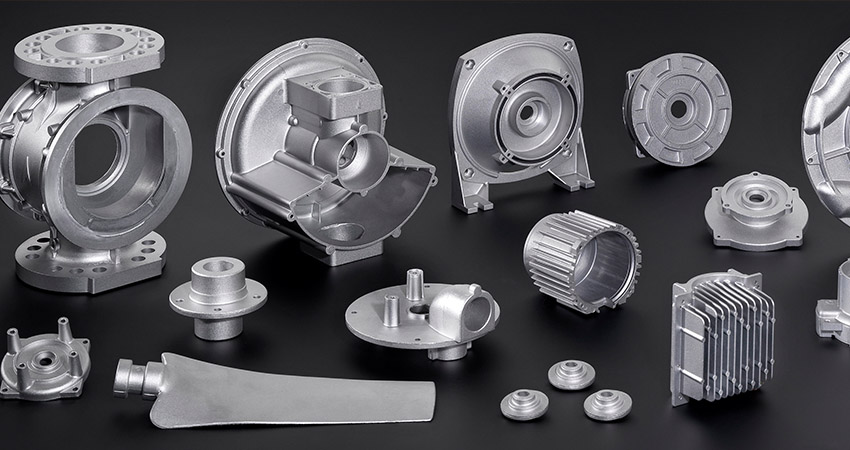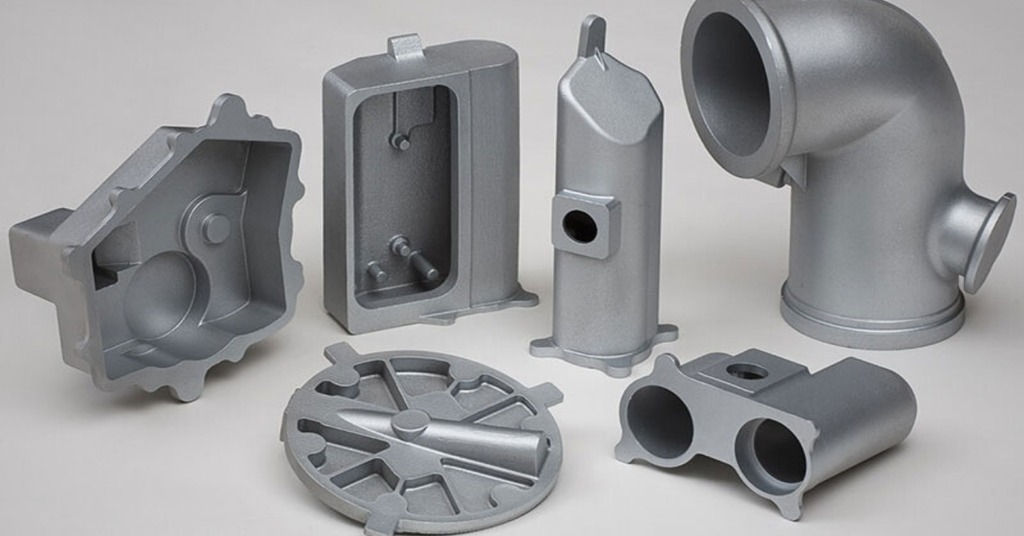Aluminum Foundry is trusted for reliability in aluminum casting processes
Wiki Article
Recognizing the Various Kinds Of Procedures in An Aluminum Foundry for Effective Manufacturing
In An Aluminum Foundry, various casting processes play an important function in manufacturing performance. Each technique, from sand spreading to die spreading, offers distinct advantages that accommodate details producing demands. Recognizing these procedures is vital for optimizing quality and cost. However, the option of casting technique can considerably influence total output. As foundries discover these choices, they must consider which methods align ideal with their production goals. What elements will eventually direct their choices?Introduction of Aluminum Foundry Processes
Aluminum Foundry processes incorporate a collection of specialized methods intended at transforming raw Aluminum right into usable parts. These processes typically begin with melting the Aluminum, where main or scrap Aluminum is warmed until it gets to a liquified state. As soon as thawed, the Aluminum may undergo alloying, where details elements are contributed to enhance its residential or commercial properties, such as toughness or corrosion resistance.Complying with melting and alloying, the Aluminum is poured into mold and mildews to develop desired forms. Cooling and solidification take place, during which the product takes on the kind of the mold. After solidification, castings are eliminated and might require more handling, including trimming, machining, or surface treatment to accomplish the final specs. Quality assurance is indispensable throughout the procedure, guaranteeing that the created parts meet sector standards. On the whole, Aluminum Foundry processes are vital for creating a vast array of light-weight and durable products utilized in numerous applications.
Sand Casting Methods
A considerable part of Aluminum spreadings are created utilizing sand casting techniques, which is a flexible technique favored for its capacity to produce complex shapes. In this procedure, a mold and mildew is made from sand blended with a binding agent, guaranteeing it can stand up to the liquified Aluminum's temperature level. The pattern, commonly made of steel or plastic, is positioned in the sand to form the cavity for the casting. After removing the pattern, the mold and mildew is filled with liquified Aluminum, which strengthens right into the desired shape upon air conditioning.Sand casting is particularly advantageous for reduced to medium production volumes as a result of its cost-effectiveness and flexibility. Additionally, it permits very easy adjustments of mold and mildew layouts, suiting different component geometries. It may not achieve the dimensional precision of various other casting techniques, the surface coating can be improved with subsequent machining. Overall, sand spreading stays a keystone of Aluminum Foundry procedures, ensuring diverse applications throughout markets.
Die Casting Techniques
In the domain of die casting methods, 2 primary processes attract attention: the hot chamber and cold chamber methods. Each technique presents distinct benefits and difficulties, particularly relating to performance and material compatibility. Furthermore, the choice of die products plays an important role in figuring out the general success and durability of the spreading process.Hot Chamber Process

Cold Chamber Refine
Cold chamber pass away casting represents a different technique for producing Aluminum components, particularly when handling steels that have greater melting points or when the molten metal is as well responsive for warm chamber processes. In this technique, molten Aluminum is put right into the die from an exterior ladle, which reduces the risk of contamination and permits greater adaptability in alloy option. The procedure includes injecting the molten metal right into a chilly die utilizing a hydraulic piston, making certain specific control over the injection speed and pressure. This method is helpful for creating complex geometries and achieving high dimensional accuracy. It may need longer cycle times compared to warm chamber processes, cool chamber die casting is crucial for particular applications in Aluminum shops.Pass Away Materials Choice
Picking the suitable die materials is essential for enhancing the die casting procedure and guaranteeing the longevity and efficiency of the mold and mildews. One of the most generally utilized products consist of tool Aluminum, steel, and beryllium-copper alloys, each offering unique advantages. Device steel is favored for its resilience and resistance to use, making it perfect for high-volume manufacturing runs. Aluminum provides exceptional thermal conductivity, helping with reliable warm dissipation, while beryllium-copper alloys incorporate toughness and thermal management homes, though at a higher price. Variables affecting the option include the intricacy of the part, anticipated manufacturing quantity, and the certain Aluminum alloys being cast. Ultimately, the appropriate option of die material can substantially enhance productivity and reduce general functional prices in Aluminum shops.Financial Investment Casting Processes
While various casting approaches exist, financial investment casting attracts attention for its capability to create elaborate shapes with high accuracy and excellent surface area finishes. This procedure includes producing a wax pattern that is covered with a ceramic covering. As soon as the covering sets, the wax is dissolved, leaving a dental caries that is full of liquified Aluminum.Financial investment casting is particularly beneficial for generating complicated geometries that would be impossible or challenging to attain with various other approaches. It enables tight tolerances, minimizing the requirement for extensive machining post-casting. In addition, the smooth surface finish minimizes the demand for second operations, thus enhancing efficiency.
This technique is extensively made use of in industries requiring detailed parts, such as aerospace and clinical fields. The versatility of investment spreading allows the manufacturing of both large and tiny amounts, making it an important choice in Aluminum factories seeking to meet diverse production demands.
Permanent Mold Casting
Long-term mold spreading is an approach that utilizes recyclable mold and mildews to develop Aluminum parts, enhancing performance in production. This strategy offers a number of benefits, including boosted dimensional precision and surface area finish, making it ideal for various industrial applications. By recognizing its procedure, advantages, and makes use of, one can value its importance in the Aluminum Foundry market.Refine Summary
Aluminum Foundry processes encompass different techniques, among which is long-term mold spreading. This approach employs recyclable molds, generally made from steel, allowing for efficient manufacturing of Aluminum components. The process begins with preheating the mold and mildew to boost fluidity and lower defects. Molten Aluminum is then put right into the mold under gravity or pressure, making sure precise dental filling and lessening air entrapment. When the Aluminum solidifies and cools down, the mold is opened to fetch the cast component. Long-term mold casting is recognized for creating high-grade, dimensionally exact parts ideal for various applications. The technique is especially beneficial for high-volume manufacturing runs, as it greatly lowers product waste and improves repeatability in manufacturing processes.Advantages of Method
Although different casting techniques exist, long-term mold casting uses distinct advantages that make it a recommended option for numerous manufacturers. This technique enables superior dimensional accuracy and surface area coating, reducing the need for extensive machining. The recyclable molds, generally made from steel, boost manufacturing efficiency by enabling fast cycle times and lower total material expenses. Additionally, irreversible mold and mildew casting advertises enhanced mechanical properties in the end product as a result of the regulated cooling prices, which cause finer grain structures. Additionally, as the procedure produces much less waste contrasted to sand spreading, it is much more eco-friendly. On the whole, these benefits add to cost-effectiveness and high-quality end results, making long-term mold casting a critical selection in the Aluminum Foundry sector.
Applications in Sector
In Aluminum Foundry different fields, permanent mold casting plays a crucial duty in producing high-quality Aluminum parts, especially where accuracy and toughness are paramount - Aluminum Foundry. This method is extensively made use of in the automotive industry for producing engine blocks, transmission housings, and various other critical components that call for precise resistances and robust efficiency. The aerospace industry advantages from irreversible mold casting for elements that should endure extreme conditions while keeping lightweight features. Additionally, customer products typically utilize this method for creating durable and aesthetically pleasing items, such as kitchenware and ornamental components. The capability to attain complex geometries and fine surface finishes makes permanent mold casting a preferred selection across diverse applications, guaranteeing reputable and efficient manufacturing in numerous commercial contextsMachining and Finishing Procedures
Precision machining and completing procedures play an essential role in the Aluminum Foundry procedure, ensuring that cast parts meet stringent high quality and dimensional specifications. These procedures entail different methods, such as milling, transforming, drilling, and grinding, which are used to fine-tune the surface areas of actors components. Each strategy is chosen based on the specific demands of the component, including its dimension, form, and intended application.Ending up processes, such as anodizing and surface sprucing up, improve the visual appeal and rust resistance of Aluminum parts. Furthermore, these operations help achieve tighter tolerances and smoother coatings, which are essential for efficiency in numerous commercial applications.
Top Quality Control in Aluminum Foundries
Quality assurance in Aluminum foundries is a vital element that assures the stability and performance of cast items. This process involves organized inspections and testing at numerous phases of manufacturing. Foundries carry out strenuous quality checks, consisting of aesthetic examinations, dimensional dimensions, and material analysis, to ascertain that every actors meets defined criteria.Additionally, progressed methods such as non-destructive testing (NDT) are employed to discover interior issues that might not show up on the surface. By checking variables like temperature and alloy make-up, factories can preserve excellent production conditions, reducing the chance of problems.
Moreover, adherence to market standards, such as ISO qualifications, enhances a foundry's commitment to top quality. Continuous training and growth of employees additionally play a crucial duty in promoting a culture of top quality recognition. Eventually, reliable quality assurance methods enhance customer contentment and reduce pricey rework and scrap, guaranteeing the Foundry's one-upmanship in the market.
Often Asked Concerns

What Precaution Are Needed in An Aluminum Foundry?
Precaution in An Aluminum Foundry consist of appropriate personal safety devices, air flow systems to manage fumes, fire prevention procedures, regular equipment upkeep, staff member training on hazards, and emergency situation response plans to address prospective mishaps properly.Just How Does Recycling Aluminum Affect Foundry Processes?
Reusing Aluminum significantly influences Foundry procedures by lowering resources costs, decreasing waste, and decreasing energy consumption. This green method improves production efficiency while advertising sustainability, ultimately profiting both the Aluminum and the environment industry.What Are the Ecological Influences of Aluminum Foundries?
The environmental impacts of Aluminum factories include air and water contamination, high energy usage, and significant greenhouse gas discharges. These factors add to environment damage and health and wellness risks for bordering communities, necessitating boosted sustainability methods.How Do Factories Manage Waste and Emissions?
Foundries manage waste and discharges with different techniques, including recycling scrap steel, carrying out purification systems, and adhering to environmental regulations. These procedures intend to lessen environmental impact while keeping functional performance and efficiency.What Is the Duty of Automation in Aluminum Foundries?
Automation in Aluminum foundries boosts effectiveness and accuracy. It decreases human mistake, maximizes manufacturing procedures, and reduces labor costs. By incorporating sophisticated technology, shops can improve product quality and guarantee regular operational performance.Aluminum Foundry processes encompass a collection of specialized techniques intended at changing raw Aluminum into usable parts. These procedures commonly begin with thawing the Aluminum, where main or scrap Aluminum is warmed until it reaches a liquified state. The hot chamber procedure is a very reliable die casting technique commonly used for Aluminum alloys. Cold chamber pass away spreading stands for a different approach for producing Aluminum elements, especially when dealing with steels that have higher melting points or when the molten metal is as well reactive for warm chamber processes. Aluminum Foundry. Aluminum Foundry processes include various techniques, one of which is irreversible mold casting
Report this wiki page